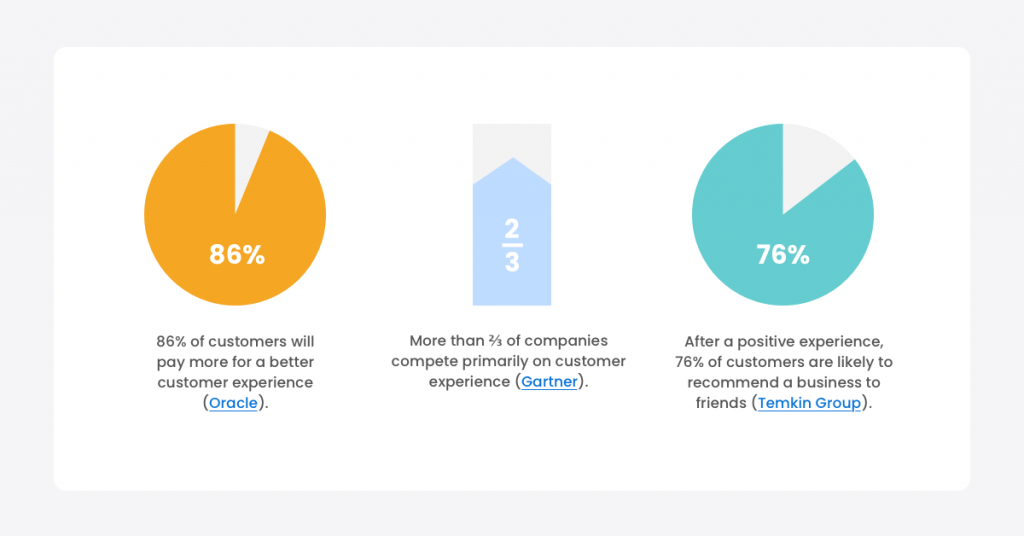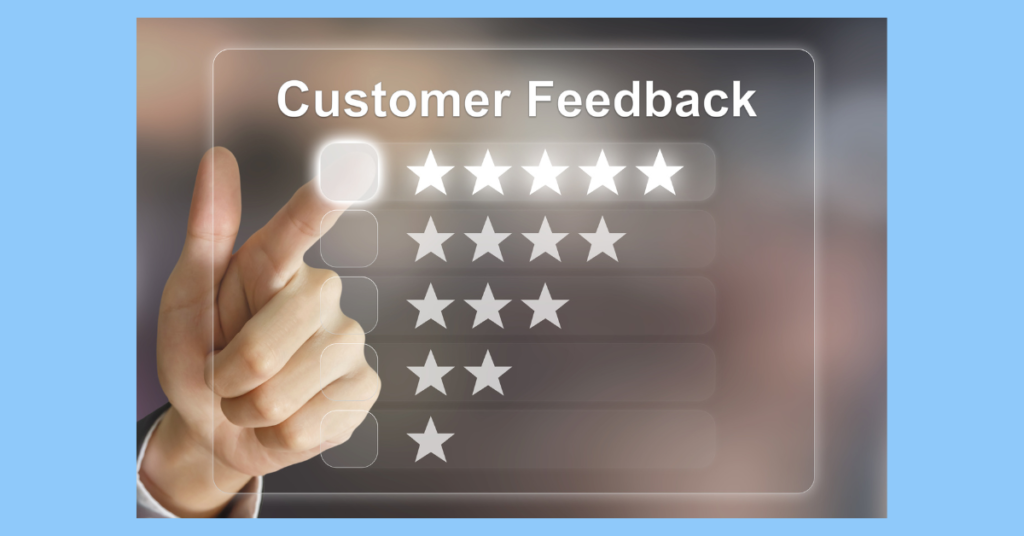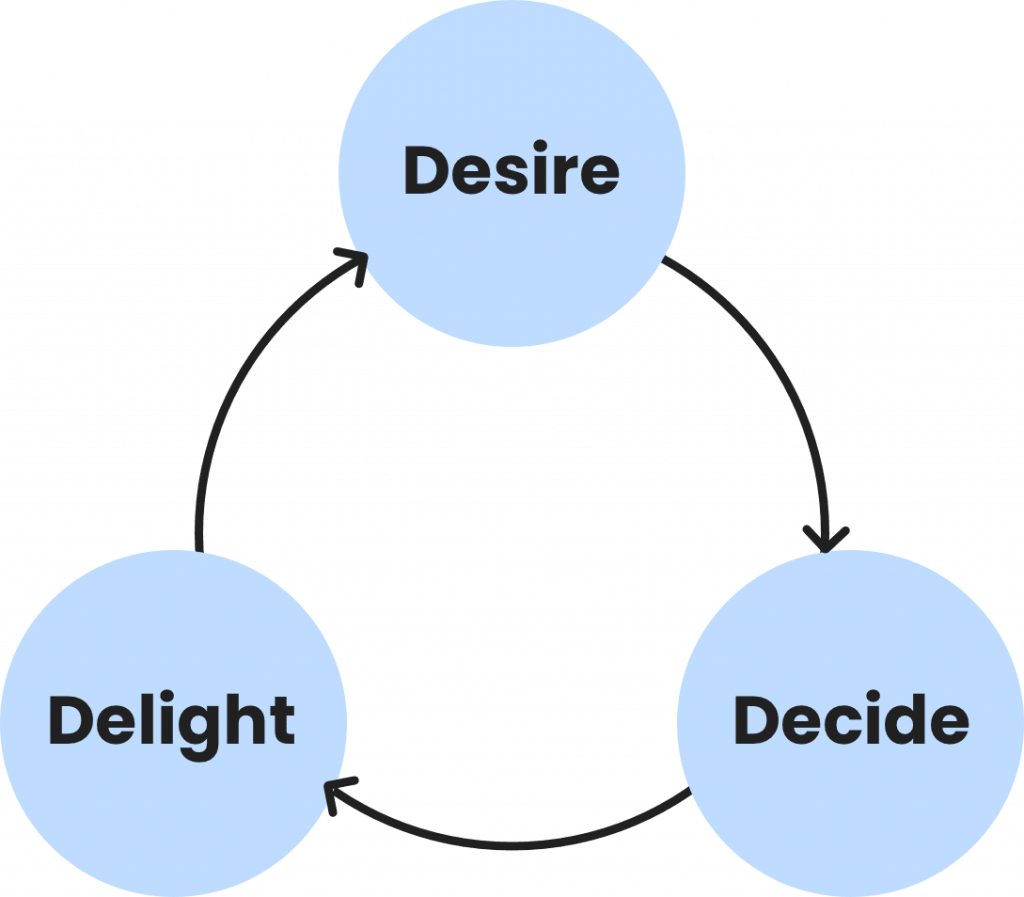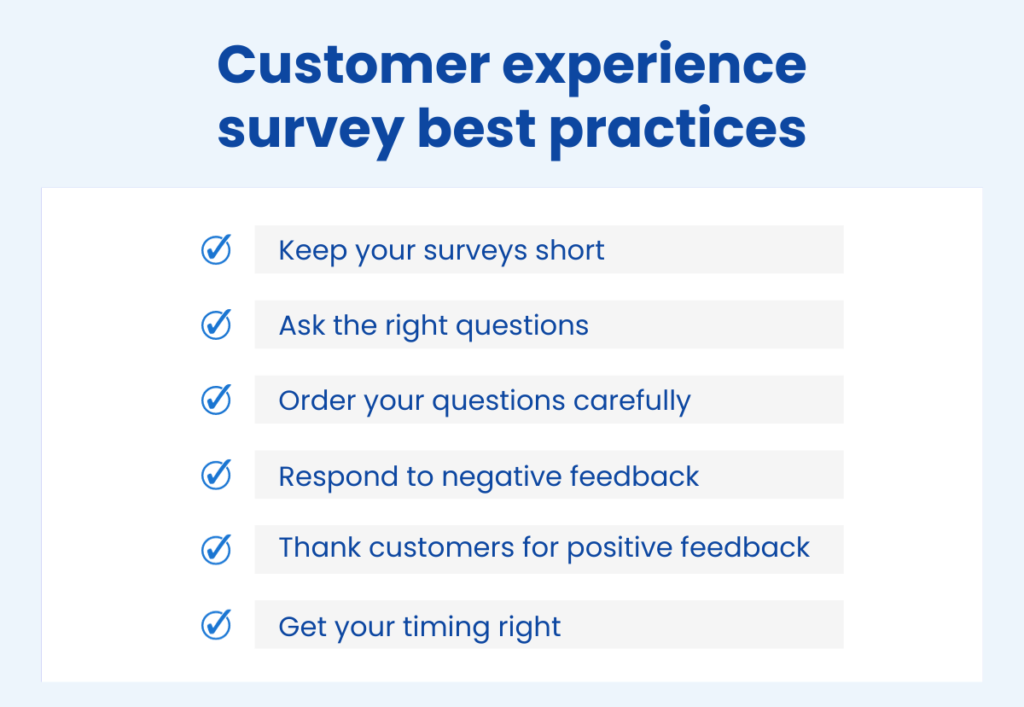Customers are more connected with each other than ever and can find businesses that serve their needs in minutes, if not seconds. If a business fails to meet customer expectations, a customer can easily find another option. According to a Birdeye study, 67% of consumers tell family and friends about their negative experiences and 62% switch to a competitor. In such an environment, the businesses that win are those that deliver superior customer experiences (CX) from the very first touchpoint.
In this blog, we’ll cover the questions that every company has about customer experience.
Table of contents
- Chapter 1: The importance of customer experience
- What is customer experience?
- What is customer experience management?
- Customer experience statistics
- Is customer experience the same as customer service?
- What is the impact of customer experience?
- How to improve customer experience?
- How can sentiment analysis be used to improve customer experience?
- Elevate customer experience with Birdeye’s AI-driven all-in-one CX management platform
- How customer experience drives business growth
- Customer experience examples
- What counts as a great customer experience?
- Why customer experience is key for loyalty programs
- Chapter 2: Getting started with a customer experience program
- What are the steps for developing a CX strategy?
- How to map your customer journey
- How to measure customer experience
- Measuring customer experience with online reviews
- 5 customer experience survey best practices
- Challenges for implementing a customer experience program
- Employee experience and customer experience – how are they connected?
- How to calculate customer experience ROI
- What to look for in a customer experience software
- Frequently asked questions about customer experience
- Get started with Birdeye
Chapter 1: The importance of customer experience
Here’s why customer experience matters for your business.

What is customer experience?
Customer experience or CX is the sum of all the experiences that your customer has across every touchpoint. For example, when a customer visits a local retailer, their experience is summed up by the process of discovering the store, making an appointment, the appointment itself, and return visits.
What is customer experience management?
Customer experience management is the process of designing your customer experience so that it consistently exceeds the expectations of your customers and leads to more loyalty over time.
Customer experience statistics
So, why is it important for customers to have a good experience? A good customer experience fosters loyalty and increases the likelihood of repeat business. According to a Birdeye study:
- 61% of consumers won’t choose a local business that doesn’t respond to a message within a day.
- Consumers are more likely to share positive experiences vs. negative responses
- 54% of consumers will post an online review after a positive experience
- 38% of consumers will post an online review after a negative experience
But that’s not all. Below are a few more statistics that show why customer experience is crucial.

Is customer experience the same as customer service?
While they are commonly confused, customer experience is not the same as customer service. Let’s break down the differences between the two.
- Customer Experience Every experience that your customer has with your business from the moment of first discovery.
- Customer Service Specific parts of the customer journey where the customer requires specific assistance from you.
Good customer service is just one component of a good customer experience. However, there are many aspects of the customer experience that don’t involve customer service at all, such as being able to book an appointment through an online scheduling system. This makes your customer experience more seamless and eliminates the need for customer service to get involved.
What is the impact of customer experience?
The impact of customer experience is significant and multifaceted. Here are a few key benefits:
- Increased customer loyalty: Positive experiences foster customer retention and loyalty.
- Positive word-of-mouth: Satisfied customers often recommend businesses to others, enhancing reputation.
- Competitive advantage: Exceptional customer experience can differentiate a business in a crowded market.
- Improved brand image: Consistently good experiences strengthen a brand’s image and credibility.
- Enhanced customer engagement: Engaging experiences can deepen customer relationships and involvement with the brand.
- Increased employee satisfaction: Positive customer feedback can boost employee morale and motivation.
How to improve customer experience?
Improving customer experience is crucial for building lasting relationships and fostering brand loyalty. Here are six key strategies to enhance your CX:
- Understand your customers: Begin by actively listening to your customers’ feedback and preferences to gain insights into their needs and expectations.
- Personalize interactions: Tailor your interactions and offerings to each customer, making them feel valued and appreciated.
- Efficient communication: Streamline your communication channels and response times to ensure quick and helpful assistance.
- Consistency across channels: Maintain a consistent and seamless experience across all customer touchpoints, whether online or in-person.
- Employee training: Invest in ongoing training for your employees to empower them with the skills and knowledge needed to deliver exceptional service.
- Feedback loop: Establish a feedback loop that allows customers to provide input and track improvements, demonstrating your commitment to their satisfaction.

How can sentiment analysis be used to improve customer experience?
Sentiment analysis can be a valuable tool for improving customer experience by providing insights into customer emotions, opinions, and feedback. Here’s how it can be used effectively:
- Real-time feedback analysis: Sentiment analysis allows businesses to quickly address customer concerns by monitoring feedback in real-time.
- Personalized recommendations: Using sentiment analysis, businesses can tailor product or service suggestions to match individual customer preferences.
- Identifying trends and patterns: Sentiment analysis uncovers recurring trends in customer feedback, aiding data-driven decision-making.
- Competitor benchmarking: Analyzing sentiment among competitors offers insights into customer satisfaction and areas for differentiation.
- Proactive issue resolution: Sentiment analysis alerts businesses to potential problems, enabling swift issue resolution and a better CX.
- Enhancing marketing campaigns: Understanding customer sentiment informs more effective marketing campaigns and messaging that resonate with the target audience.
Elevate customer experience with Birdeye’s AI-driven all-in-one CX management platform
Assuring consistent customer experience can be challenging for a growing business managing multiple locations, yet it is more important than ever. Also, the Birdeye study on customer experience indicates that over 60% of customers would switch to a competitor following a bad customer experience.
Customer expectations have also increased significantly, demanding a seamless experience across social media messaging channels, web chat, SMS, and more.
Managing this without the proper tools can lead to stretched resources and unhappy customers – a situation no business wants to find itself in.
Enter Birdeye. With a deep understanding of the market, we’ve developed BirdAI to help you address the most common issues in customer experience management, ensuring your business stays ahead of the competition and your customers remain happy.
With our AI-driven platform, businesses can:
- Understand their customers by generating AI-generated summaries for reviews, customer conversations, and feedback via surveys. You can know what the major pain points are and evaluate customer requirements with the click of a button.
- Ensure they are available 24/7 to their customers, with AI assistant Robin stepping in to answer FAQs and allowing agents to step in for complicated queries.
- Present a professional, consistent, branded front to customers across all channels. Our AI assistant helps you rephrase, change the tone, and fix typos in every conversation.
- Offer a faster resolution with an auto-ticketing system for negative reviews and survey responses.
- Respond professionally to all reviews with AI-generated review responses.
- Scale their social media channels with AI-generated ideas for social media posts and reach more customers with industry-specific hashtag recommendations.
Related read: How to use AI to improve customer experience
How customer experience drives business growth
Customer experience matters for a simple reason: It gets your customers to stick around. While building a great customer experience might take time and effort, the return is well worth it. Building stronger relationships with your customers mean higher levels of customer retention, which means more revenue for your business. This relationship not only shapes customer experience but also serves as a catalyst for customer referral marketing by influencing customer behavior and encouraging them to refer others to your business.
Customer experience today is not the same as it was ten years ago for most businesses. Nowadays, it’s important for every business, no matter what industry, to embrace digital transformation.
A study by MIT found that companies that embrace digital transformation are 26% more profitable than their competitors. It’s not difficult to figure out why. Digitizing your processes means more efficiency and a more smooth journey for the customer.
“Today, over 150,000 businesses globally use Birdeye to manage digital customer experiences. They use our all-in-one platform to go digital using the power of AI. These businesses use Birdeye to manage their online reputation, connect with their customers through digital channels, and gain critical customer insight.”
Naveen Gupta, CEO of Birdeye
Customer experience examples
To illustrate why customer experience leaders consistently beat the competition, consider a customer experience example from a company that’s debatably the biggest customer experience leader of our time: Amazon.
Here are three things that any business can take away from the Amazon shopping experience.
- Seamless experience for customers – The process of turning a prospect into a customer is easy and seamless. When a customer is interested in a product, they can easily find different options and look at customer reviews to help them make their decision. When it’s time to make the purchase, the customer does not need to jump through hoops in order to get the product delivered. All it takes is one click.
- Easy communication – Dealing with Amazon customer service is never a headache. It’s always easy to get in touch and get a solution to a problem. Unfortunately, this is not the case for most businesses. Anyone who’s ever had a frustrating experience with getting put on hold while trying to reach a representative knows that experiences like these can hurt your views of the brand.
- Data feedback – You may have noticed Amazon’s great product recommendations that show up after purchase. How does Amazon have such remarkably accurate insights into what customers are interested in buying? Amazon uses data points from customers all around the world to see what shoppers like you are looking for. The company uses this data to improve product recommendations and provide a better customer experience.

These lessons from Amazon can be applied to improve the customer experience for all businesses. While not every business can afford the kind of capital investments that Amazon makes, every business can resolve to make the overall experience better for customers by creating a seamless experience, making customer communication easy, and utilizing data insights.
What counts as a great customer experience?
Ideally, a customer experience leads to loyal customers who not only are happy to keep coming back to your business but act as an evangelist and bring friends and family to your business as well. In order to create a perfect customer experience, you’ll need to make sure that you’re delivering value for your customers at every touchpoint. Still wondering what is CX? A good customer experience is defined by:
- Satisfaction: Meeting or exceeding customer expectations.
- Ease of interaction: Effortless interactions between the customer and your business — omnichannel availability is a must.
- Personalization: Tailored experiences addressing individual customer needs and preferences.
- Consistency: Uniform quality across all touchpoints and channels.
- Positive engagement: Memorable, engaging interactions that leave a lasting positive impression.
- Problem resolution: Efficient and effective handling of any issues or complaints.
So how can you ensure that you’re delivering the perfect customer experience to as many customers as possible? The answer is to develop a customer experience strategy. A customer experience strategy is how you aim to deliver a scalable, repeatable, and consistent experience across every customer touchpoint. We’ll go into more detail about how you can create a winning customer experience strategy later in the article.
Why customer experience is key for loyalty programs
A loyalty program is a marketing strategy designed to encourage customers to continue to shop at or use the services of a business. Customers are rewarded for their loyalty by giving them incentives like discounts, free products etc. Successful loyalty programs drive significant value for brands and are critical for a company’s growth. Consumers who participate in loyalty programs are 80% more likely to choose the brand over competitors and twice as likely to recommend the brand to others.
Although loyalty programs can help boost revenue, the success of these programs is heavily dependent on the experience that customers have with the brand. If the experience is positive, the customers keep coming back for more and make the loyalty program successful. Negative customer experiences, on the other hand, can spell disaster for loyalty programs.
Chapter 2: Getting started with a customer experience program
Here’s how you can get started improving your customer experience or CX.
What are the steps for developing a CX strategy?
Companies that focus on customer experience are able to reduce churn and increase revenue. Having a definitive customer experience strategy in place decides how a customer is made to feel at every stage of the customer journey. Here are three steps that you can take to develop a successful customer experience strategy.
- If you’re starting a new customer experience program, it’s a good idea to draw up a customer experience intent statement. This is 1-2 paragraphs that describe your goals for interacting with customers.
- Collect data on each one of your touchpoints with customer surveys. Leverage this data to both show weak points and build on areas you’re already excelling.
- Collect information on your competitors. Use online reviews to get a better idea of some of the strengths and weaknesses of your competitors’ experience, and use this information to build your strategy.
How to map your customer journey
Every customer experience framework starts with mapping the customer’s journey. The customer journey is a representation of your customer’s lifecycle from awareness to advocacy. Here are a few steps that you can take to map your customer journey.

Step 1: Define the different stages of your customer’s journey
Your potential customers go through different behavioral stages as they move through the customer journey. Consider whether your prospects are just becoming aware of their problem or if they’re ready to become a customer. Define the different stages of your journey, as this will give you an idea of how you can keep them moving forward.
Step 2: Determine customer motivations at each stage
In order to know how to get your customers to complete the journey, you need to understand what they’re looking for at each stage. Collect feedback so you can get a better understanding of customer expectations.
Step 3: Plot your touchpoints
Look at the different touchpoints where your customers are interacting with. See how customers are moving from one touchpoint to another. For example, maybe your customers are using your website chat to make appointments but interacting with you via text to ask specific account-related questions.
Step 4: Determine if the journey is working as intended
Take a closer look at the actions your customers are taking. See if there are any places where customers are leaving in the middle of their journey. Determine whether all of these touchpoints are actually meeting the needs of your customers.
Step 5: Make improvements
Start making improvements on the touchpoints that are obstructing the customer journey. For example, customers may be trying to text you on your landline, and it is not set up to send or receive texts. Make your landline textable and remove the roadblock.
How to measure customer experience
In order to be able to effectively manage your customer experience, it’s important to measure customer experience across different metrics. There is no one-size-fits-all – so choose from any of the following metrics that work for your business.
- Net promoter score – Net promoter score measures how likely your customers are to recommend your business to friends and family on a scale of 0-10. High NPS shows that your customers are willing to promote your business.
- Customer churn rate – The churn rate is the percentage of customers who stop using your business over a certain time period. High churn rates are a sign the customer experience you’re providing does not align with your customer’s expectations.
- Customer satisfaction score – Customer satisfaction score (CSAT) is an indicator of overall levels of satisfaction with your customer experience (as you might expect). To measure CSAT, simply ask your customers a question like “How satisfied are you with your experience?”
- Trends in customer ticketing – If you’re seeing large amounts of customer service tickets arising from particular touchpoints, chances are there’s room for improvement. Take a look at these tickets and try to determine where these complaints are coming from.
Measuring customer experience with online reviews
Online reviews are a great way to improve your customer experience, no matter what stage of the customer’s journey your customer or prospect is in. Here are a couple of reasons why online reviews can help your business.
- Display social proof – Reviews are a great way to show some of the value propositions of your products and services with a voice your customers trust: the voice of other customers. Reviews represent the authentic opinions of your customers, making them a trusted source of information.
- Understand overall satisfaction – Customers will often provide valuable feedback within reviews that can help you understand both strengths and weaknesses in your overall experience (ex. “Love their food, but the wait is too long!”) This can help you understand how you can improve your touchpoints to better serve customer needs.
“When we partnered with Birdeye we had 13,000 reviews, and now fast-forward to 6.5 to 7 years later, we are now up to 135,000 reviews across all of our locations and people. From where we started, that’s 800% growth.”
Melissa Wright, CMO of American Pacific Mortgage
5 customer experience survey best practices
In order to build a great customer experience, it’s important to collect quality feedback. Let’s talk about how you can design a customer experience survey.

- Keep your surveys short
Time is money. Nobody wants to spend time taking long surveys. Surveys that are too long or too complex frustrate respondents, resulting in skipped questions or drop-offs. Make sure that your surveys are 7-8 questions at the longest. - Ask the right questions
While an open-ended question can yield some great insight, they do take more time for a customer to complete. Again, a survey that is too lengthy will not be completed by your customers, so do not ask too many open-ended questions. Also, consider making them non-mandatory. - Order your questions carefully
If you start off with a complex question right away, you might see respondents dropping off. Instead, start off with a couple of questions that are easy to answer to get them accustomed to the survey-taking process. - Respond to negative feedback
If a customer provides negative feedback, get in contact with them right away. If you respond quickly, you do have a chance of turning the customer’s opinion around. - Thank customers for positive feedback
If your customers have given you positive feedback, make sure to reach out. A simple “thank you” can go a long way in helping to build customer loyalty. - Get your timing right
To get the most accurate results, it’s important to send customer experience surveys at the right time. What the right time depends on whether you’re measuring overall customer experience via a relationship survey or a specific touchpoint via a transactional survey.
Challenges for implementing a customer experience program
Here are a few challenges that can get in the way of implementing an effective customer experience program.
- Missing opportunities to personalize – Businesses often miss the opportunity to personalize their customer experience in order to fit the customer’s unique needs. The biggest challenge is not the lack of motivation. Instead, businesses don’t have the information they need to implement personalization. In order to personalize the customer experience, you need to have data on your customers’ past interactions with you. Make sure that you keep records of previous conversations as well as in-store visits.
- Getting humans and technology to work together – A great customer experience strategy means nothing if your employees don’t understand the tools they’re using and don’t have the data that they need. Make sure that the software that you’re using doesn’t turn out to be burdensome and impossible to figure out. You want a platform that is so intuitive that employees at all levels are comfortable using it.
- Staying on top of multiple channels – Most customers will not stick to a single channel when it comes to contacting a business. Studies show that 66% of customers use at least three different communication channels to contact a business. While having a message slip through the cracks is understandable when you’ve got so many different things to worry about, it’s frustrating for customers. Make sure that your employees are staying on top of all customer messages. Otherwise, frustrated customers will often turn to your competitors.
- Data organization – Most businesses have dedicated teams handling different channels. Your call centers, physical locations, and website might have completely different teams who have completely different processes and have access to completely different data on your various channels. That’s why it’s important to adopt an omnichannel approach to customer experience. That means investing in an Experience Marketing platform that allows you to keep track of all of your customer interactions in one place.
Employee experience and customer experience – how are they connected?
Happy employees are better able to serve your customers. Here are a few ways that you can help improve your employee experience.
- Share customer feedback with employees
If the employees don’t see the impact that their work is actually having on their business, it can quickly lead to dissatisfaction. So don’t keep positive feedback to yourself. Share glowing reviews and positive feedback with your team. It’s an easy way to show that they’re doing work that matters. - Improve your team collaboration
Your employees want to be sure that your team collaboration processes are smooth and easy to follow. A confusing process might lead to frustration for both your employees and your customers.
Make sure you’re investing in tools that help to make team collaboration easy, whether that’s project management software that allows different departments to work together on different projects or interactions management software that allows customer messages to be handed off to relevant teams. - Conduct periodic employee surveys
Some of the same tools that you can use to improve customer experience can be used to help improve employee experience as well. Make sure that you’re rolling out regular employee surveys to understand their concerns and frustrations.
How to calculate customer experience ROI
There’s no one-size-fits-all approach to customer experience. It’s important to make sure that your investments in customer experience are paying off. Here are a few steps that you can take to calculate your ROI from customer experience.
- Define clear goals – Once you’ve established the metrics that are most important to your business, set some quantifiable goals. Make sure that you get buy-in from your employees. You want to be sure that everyone on your team knows why you’re focusing on the metrics that you’ve chosen and why it’s important that they need to be improved on.
- Establish a baseline – It’s important to know how your customer was performing before you made any new investments in customer experience. If your goal is to improve NPS, keep a record of where your NPS is to start. This will help you understand how effective your efforts are in actually helping you to achieve your goals.
- Calculate value from improvements – Figure out the value of a highly satisfied customer. For example, maybe you’ve seen that a strong loyal customer spends more than 30% more than a passive customer. That means that you should be able to predict the increases in revenue that you see from an improvement in NPS.
- Subtract costs – In order to calculate ROI, you do need to subtract costs from your revenues. This will show you how much you’re getting back on your investment in real dollar terms. If you find that the costs of your customer experience invest the revenue, consider doing some readjustments.
What to look for in a customer experience software
Here are a few things that you should look for when choosing customer experience software.
- Meet customers everywhere with Birdeye Messaging
Birdeye Messaging sends every text, message, and convo straight to your inbox — making it easy to follow up on voicemails, chat with leads and customers, create campaigns, and even create custom campaign triggers all from a single shared location. - Send customer surveys
Make sure that your customer experience software allows you to send customer surveys via text and email. Quality feedback helps you improve your touchpoints and delight your customers. - Get actionable insights with natural language processing
It can be tough to manually get insights from reviews. But natural language processing can help you. If customers are complaining about a category like “customer service” or “wait time”, you’ll know immediately.
Frequently asked questions about customer experience
The ideal customer experience is to make your customers feel valued and satisfied with their purchase or service from the moment they start interacting with your business. The entire customer journey from start to finish should be positive.
Customer experience is important for building long-term relationships with your customers. When you provide them a positive experience, they’ll likely tell others how great their experience was through online reviews or word of mouth. A positive customer experience will go a long way when it comes to repeat business.
Customer experience (CX ) is the whole picture of a customer’s interactions with your business. CX is everything from how your business communicates with customers on your website to what they experience when receiving their product. The customer’s perception of all their interactions with your business shapes their perception of your business.
Get started with Birdeye
There is only one comprehensive Experience Marketing platform on the market: Birdeye. Birdeye is the only platform that offers a unified Inbox for customer interaction, customer reviews and surveys, and natural language processing.
If you’re looking to deliver a fantastic customer experience across all of your touchpoints, get started with a demo. Find out why more than 150,000 businesses use Birdeye to improve customer experience.




Originally published



